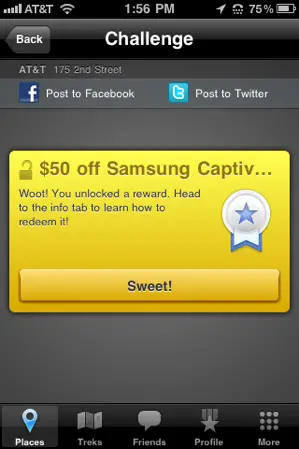Bunchball
"Putting the Fun in Functional: Applying Game Mechanics to Functional Software"
Daisy Whitney's New Media Minute
Coincident TV
In searching for some good examples of New Media, I set myself guidelines for the search:
- The media successfully gets people to interact in both the real and virtual worlds.
- It's accessible and far reaching.
- It is community driven and creates dialogue.
- There are numerous points of entry.
- It combines text, imagery, sound, video & function.
First Find
I first discovered “BunchBall,” a company that specializes in developing games to get consumers to be further engaged in a company’s website, prolonging time spent on websites and creating positive interactions between potential customers.
 “Gamification” : integrating game dynamics into your site, service, community, content or campaign, in order to drive participation.
“Gamification” : integrating game dynamics into your site, service, community, content or campaign, in order to drive participation.This lead me to Scvngr, which develops this concept even more by putting the “game” portion in the real world.

- Members of Scvngr are given challenges to complete in the real world.

- Members go out and complete these challenges, record that it was completed through pictures and “checkins,” and then receive points for completing it.

- The points are accumulated and members can receive rewards.
- Companies offer rewards through Scvngr, because the game drives customers to their businesses.
- Members connect and compete with friends, and follow different “Treks” (challenges), to motivate involvement.

The creator of Scvngr is Seth Priebatsch, a 21 year old, Princeton drop out who had an idea with huge potential. He was named America's 2009 Best Young Entrepreneur, and has a staff of 60.

This New Media application has worked because,
- It's engaging and goal oriented.
- Taps into a collecting mentality (points); redeemable points drive loyalty.
- Encourages competition and tracking between friends.
- Connects with Social Networking sites; Facebook and Twitter (many touchpoints).
- Businesses don’t have to sacrifice much to be a part of “the game,” and are motivated by the huge benefit of the game telling consumers to go to their business to accomplish a challenge.
- Gets people outside into the real world.
Second Find
Canada Tourism keeps connected with all the latest Social Networking sites, and has used its power to promote travel within Canada.
Through daily blog entries, facebook and twitter updates, those traveling Canada can stay connected with where to go, depending on what kind of traveler they are, and also catch-up on what other travelers are doing.
Canada Tourism started a campaign to address the problem of getting American’s to realize the travel potential right next to them. They used New Media to engage clients in the United States . . .
The Interactive Twitter Wall (Video)
- Installed in major cities, such as New York, Chicago and LA.
- A live stream of photos and comments from travelers in Canada.
- Walkers-by can stop and interact with the screen.
- Staff available on-site to provide further material, etc.

- People are then inspired to visit the Canada Tourism website, which has further information and constant updates of “what you can do.”

- There's a back and forth exchange, allowing customers to customize their experience and therefore have further investment and involvement.

- Blog documenting people’s actual experience.

It works because,
- It connects people’s real experiences, developing a group mentality.
- The giant interactive mural in the physical world structures the back and forth exchange; curiosity.
- People are familiar with Social Media; already know how to interact with it.
- The “live feed” aspect makes things immediate and evokes a response; virtual world constantly keeps information up-to-date; inspires people to do further research.
Conclusions
- New Media becomes powerful when it consists of multiple elements.
- Real world experience is still a very important part of it.
- Companies need to think on a grander scale, implementing numerous points of contact, keeping users engaged with up-to-date information and rewarding desired behaviors (good feedback).


No comments:
Post a Comment